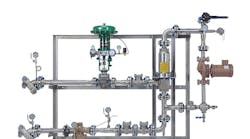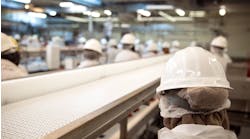Cleaning a food plant is like feeding the troops: It’s expensive, mundane and won’t bring you glory by itself, but not doing it right can sure make you lose.
"Cleaning" and "sanitation" are sometimes used interchangeably, but strictly speaking, cleaning means removing dirt, debris, residue and everything else that isn’t supposed to be on a surface; sanitation involves ridding the cleaned surface of microorganisms, usually with biocides like bleach.
Like many food plant operations, cleaning and sanitation require a balance between thoroughness and effectiveness on the one hand, and aspects like efficiency and economy on the other. Finding the right balance is a matter of choosing the right equipment, supplies and overall system.
One choice that sometimes arises is whether to clean machine components where they are or to detach and clean them separately. The former is more efficient; the latter takes more time, but is more thorough and often saves water and chemicals.
Out-of-place washers, like this one from Douglas Machines, can do a thorough job while economizing on water and chemicals.
Kevin Quinn, sales manager of Douglas Machines Corp. (www.dougmac.com), recalls the case of a peanut butter processor that was using lots of high-pressure water to clean out 72-in.-long pipes that fed the product from a mixer to an injector.
“Normally, the only way they cleaned those pipes was by using a hose to force the product out of a pipe—but of course, all that water and product is going down the drain,” Quinn says. Douglas furnished a clean-out-of-place wash tank long enough to accommodate the pipes, with water pumped from one end to the other to flush them out. “In this way we’re able to conserve that wash water and detergent and use it for cleaning any number of pipes, one after another.”
Whatever the cleaning method, another requirement is supplying water at the proper volume, temperature and pressure. The basic alternatives are: using hot water from the plant’s regular supply; heating the water with dedicated heat exchangers; or heating the water as close to the sanitation point as possible, through heating elements or steam injection.
Steam-injection systems can bring consistent temperatures to cleaning operations while saving energy. Photo: Pick Heaters
Pick Heaters (www.pickheaters.com) is a supplier of steam injection sanitation systems. Pick claims that steam injection can save up to 28 percent in energy costs over heat exchangers, “because 100 percent of the available energy from the steam is instantly absorbed by the liquid,” according to a company spokesperson. Because the water is heated near the point of discharge, the supply of hot water is virtually unlimited. Other advantages the company touts include a wide operating range and low noise level.
Applying pressure
Consistency in pressure is as important as it is in temperature. This can be a problem when demands for water vary at different points in a pipeline. One way to maintain pressure is to boost it with dedicated pumps at points where high pressure is periodically needed.
Grundfos (www.grundfos.com) recently came out with a line of centrifugal pumps for this purpose. Its BoosterPAQ multistage pumps cam be arranged to add just enough power to the water supply to keep pressure where it needs to be.
The method of delivery isn’t the only variable in a cleaning/sanitation system. A good system will take into account the variations and requirements of each individual application, starting with the water itself.
“You have to look at the city water that’s coming into the plant,” says Mark Swanson, CEO of Birko Corp. (www.birkocorp.com), a supplier of cleaning products and services. “Water in Oklahoma is not the same as water in Wisconsin.” Birko custom-blends chemicals after analyzing each customer’s water for hardness and other factors.
Matching chemicals to the application is vital, because each application differs in terms of what has to be cleaned up, how much, and how tough it is. Relevant factors include considerations like whether the soil has fats, calcium or other hard-to-clean components, how often the cleaning will take place and whether the surface to be cleaned is food-contact.
The choice of chemicals also has an impact on equipment specifications. “The selection of the materials, in how the machine is manufactured, is based strongly on what type of chemicals” are used, says Quinn. A bakery that uses a relatively mild detergent could use equipment with a cast-iron pump and motor; a meat processor that has to harsher cleaners like sodium hydroxide would require stainless steel components.
Dispensing with problems
Another challenge is getting workers to dispense cleaning chemicals properly. If they don’t use enough, or use the wrong ones, they won’t clean and sanitize effectively; if they use too much, they’re wasting money. This problem can be compounded when sanitation is done on the third shift, or in some other arrangement when supervision is diminished, and when it’s done by workers whose first language is not English.
Automatic dispensing systems have alleviated these concerns for decades. But some suppliers, like Ecolab (www.ecolab.com), are taking these into the information age. Ecolab’s Quadrexx Pro system tracks and keeps records of what chemicals have been dispensed – information that can be used on several levels.
Quadrexx Pro comes with a controller that regulates all aspects of the cleaning chemical dispensing system, including the water pressure gauge, air valves, water flowmeter, chemical mixing manifold, concentrate flowmeters and output valves. Each controller can be used with up to six dispense modules. The system tells a dedicated web portal in real time which chemicals have been dispensed, in what amounts, at what times. This data can be used for compliance with regulations like the Food Safety Modernization Act, for comparison across departments or facilities and for many other purposes.
If you have any doubts at all about the abilities of your own people, you should consider a contract sanitation company. PSSI (www.pssi.com) combines decades of experience with in-house microbiologists, chemical partners and safety specialists. They could be your third shift with no headcount added onto your books.
"With the myriad of business concerns at a food processing company, sanitation may not be top-of-mind for the CEO," says Doug White, senior vice president of PSSI. His company should lead yours to safer sanitation practices, better documentation and even improved sanitary design. Because of its singular focus on sanitation, the company keeps abreast of best practices in this field.
Going green
One of the strongest recent trends for cleaning chemicals in general is for them to be more ecologically benign. So-called “green cleaners” have carved out a share of the household cleaner market that’s still small, at about 3 percent market share, but is growing, with products rolled out by mainstream companies like Unilever.
Their impact in food processing is harder to judge. Cleaning takes place out of sight of the consumer, and efficacy is the first priority for plant personnel.
Tom Parris, corporate manager for food processing sanitation at Spartan Chemical Co. (www.spartanchemical.com), says he hasn’t seen an overwhelming demand for ecologically friendly cleaning products.
“People understand that to get rid of things like fats and oils, you need something that’s alkaline or acidic,” Parris says. “But if you can give them something green, it’s great to have that option.” One such option from Spartan is High Acid Cleaner FP Phosphate-Free, a clean-in-place solution for mineral deposits that’s 40 percent citric acid.
Organic cleaning products are sometimes seen closer to the floor, where pristine appearance and performance are not as necessary as it is for food-contact surfaces. One such product is Security Floor Treatment from Nelson-Jameson, used to clean floors, entryways and drains.
“It is classified as green and even Organic Materials Review Institute-listed for organic use,” says Pam Puttkamer, Nelson-Jameson’s product manager for chemicals and packaging. “The product truly sells itself and we continue to see growth year over year.”
Meritech (www.meritech.com) is about to launch a Perifoam-based chemical for boot-washing that it’s positioning as compatible with organic processing. It’s an alternative to quaternary ammonium-based cleaners, which have been linked to skin and lung irritation when used improperly.
Another advance in environmentally friendly cleaning chemicals comes from Spraying Systems Co. Its Klarion system (www.klarion.com) produces sodium hydroxide cleaner and hypochlorous acid sanitizer on-site from water, salt and electricity. These are not only more environmentally benign than standard cleaning chemicals, but can be used by workers without cumbersome protective gear.
Proper cleaning and sanitation are vital to food plant operations, but as with many operational aspects, competing concerns must be balanced. New chemicals and application systems can help food processors find the right balance.


